
Uraninite, also known as pitchblende, is a radioactive, uranium-rich mineral and ore with a chemical composition that is largely UO2 but because of oxidation typically contains variable proportions of U3O8. Radioactive decay of the uranium causes the mineral to contain oxides of lead and trace amounts of helium. It may also contain thorium and rare-earth elements.
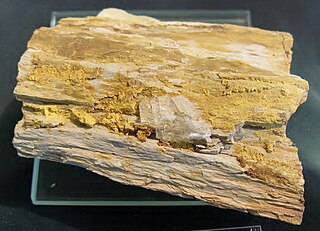
Carnotite is a potassium uranium vanadate radioactive mineral with chemical formula K2(UO2)2(VO4)2·3H2O. The water content can vary and small amounts of calcium, barium, magnesium, iron, and sodium are often present.

Autunite (hydrated calcium uranyl phosphate), with formula Ca(UO2)2(PO4)2·10–12H2O, is a yellow-greenish fluorescent phosphate mineral with a hardness of 2–2+1⁄2. Autunite crystallizes in the orthorhombic system and often occurs as tabular square crystals, commonly in small crusts or in fan-like masses. Due to the moderate uranium content of 48.27% it is radioactive and also used as uranium ore. Autunite fluoresces bright green to lime green under UV light. The mineral is also called calco-uranite, but this name is rarely used and effectively outdated.
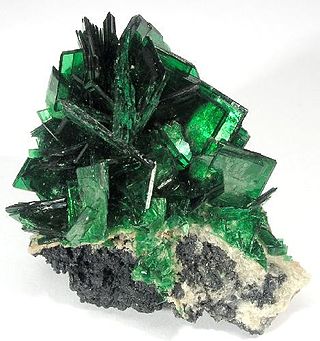
Torbernite, also known as chalcolite, is a relatively common mineral with the chemical formula Cu[(UO2)(PO4)]2(H2O)12. It is a radioactive, hydrated green copper uranyl phosphate, found in granites and other uranium-bearing deposits as a secondary mineral. The chemical formula of torbernite is similar to that of autunite in which a Cu2+ cation replaces a Ca2+ cation. Torbernite tends to dehydrate to metatorbernite with the sum formula Cu[(UO2)(PO4)]2(H2O)8.

Abernathyite is a mineral with formula K(UO2)(AsO4)·3H2O. The mineral is named after Jesse Evrett Abernathy (1913–1963) who first noted it in 1953 in the U.S. State of Utah. It was described as a new mineral species in 1956. Abernathyite is yellow and occurs as small crystals.
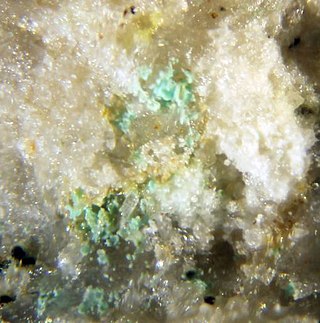
Cesbronite is a copper-tellurium oxysalt mineral with the chemical formula Cu3Te6+O4(OH)4 (IMA 17-C). It is colored green and its crystals are orthorhombic dipyramidal. Cesbronite is rated 3 on the Mohs Scale. It is named after Fabien Cesbron (born 1938), a French mineralogist.
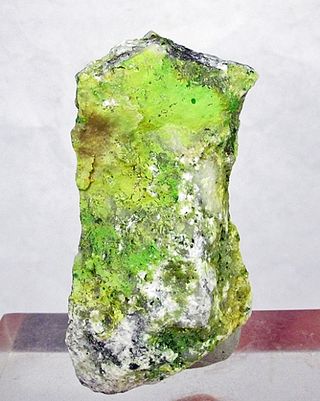
Xocomecatlite is a rare tellurate mineral with formula: Cu3(TeO4)(OH)4. It is an orthorhombic mineral which occurs as aggregates or spherules of green needlelike crystals.

Beraunite is an iron phosphate mineral. It was first described by August Breithaupt for an occurrence in Beraun currently in the Czech Republic. Beraunite occurs as a secondary mineral in iron ore deposits, and as an alteration product of primary phosphate minerals in granite pegmatites.
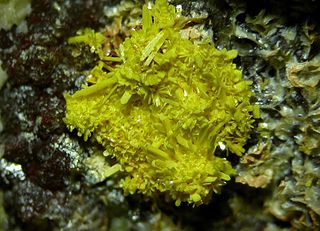
Bergenite is a rare uranyl phosphate of the more specific phosphuranylite group. The phosphuranylite-type sheet in bergenite is a new isomer of the group, with the uranyl phosphate tetrahedra varying in an up-up-down, same-same-opposite (uuduudSSOSSO) orientation. All bergenite samples have been found in old mine dump sites. Uranyl minerals are a large constituent of uranium deposits.

Johannite is a rare uranium sulfate mineral. It crystallizes in the triclinic crystal system with the chemical composition Cu[UO2(OH)SO4]2·8H2O. It crystallizes in the triclinic system and develops only small prism or thin to thick tabular crystals, usually occurs as flaky or spheroidal aggregates and efflorescent coatings. Its color is emerald-green to apple-green and its streak is pale green.

Boltwoodite is a hydrated uranyl silicate mineral with formula (K0.56Na0.42)[(UO2)(SiO3OH)]·1.5(H2O), distinct in crystal structure from sodium boltwoodite, which has an orthorhombic structure rather than monoclinic. It is formed from the oxidation and alteration of primary uranium ores. It takes the form of a crust on some sandstones that bear uranium. These crusts tend to be yellowish with a silky or vitreous luster.

Utahite is an extremely rare secondary copper zinc tellurate mineral found as a product of oxidation. Its chemical formula is Cu5Zn3(Te6+O4)4(OH)8•7H2O.

Bayleyite is a uranium carbonate mineral with the chemical formula: Mg2(UO2)(CO3)3·18(H2O). It is a secondary mineral which contains magnesium, uranium and carbon. It is a bright yellow color. Its crystal habit is acicular but is more commonly found as crusts on uranium bearing ores. It has a Mohs hardness of about 2-2.5.
Fermiite is a rare uranium mineral with the formula Na4(UO2)(SO4)3·3H2O. Chemically related minerals include oppenheimerite, meisserite (which is also structurally-related to fermiite), belakovskiite, natrozippeite and plášilite. Fermiite comes from the Blue Lizard mine, San Juan County, Utah, USA, which is known for many rare uranium minerals. The name honors Enrico Fermi (1901–1954).
Belakovskiite is a very rare uranium mineral with the formula Na7(UO2)(SO4)4(SO3OH)(H2O)3. It is interesting in being a natural uranyl salt with hydrosulfate anion, a feature shared with meisserite. Other chemically related minerals include fermiite, oppenheimerite, natrozippeite and plášilite. Most of these uranyl sulfate minerals was originally found in the Blue Lizard mine, San Juan County, Utah, US. The mineral is named after Russian mineralogist Dmitry Ilych Belakovskiy.
Meisserite is a very rare uranium mineral with the formula Na5(UO2)(SO4)3(SO3OH)(H2O). It is interesting in being a natural uranyl salt with hydrosulfate (hydroxysulfate) anion, a feature shared with belakovskiite. Other chemically related minerals include fermiite, oppenheimerite, natrozippeite and plášilite. Most of these uranyl sulfate minerals was originally found in the Blue Lizard mine, San Juan County, Utah, USA. The mineral is named after Swiss mineralogist Nicolas Meisser.
Oppenheimerite is a very rare uranium mineral with the formula Na2(UO2)(SO4)2•3H2O. Chemically related minerals include fermiite, natrozippeite, plášilite, belakovskiite and meisserite. Most of these uranyl sulfate minerals were originally found in the Blue Lizard mine, San Juan County, Utah, US. The mineral is named after American Theoretical physicist J. Robert Oppenheimer.
Manganoblödite is a rare manganese mineral with the formula Na2Mn(SO4)2·4H2O. Somewhat chemically similar mineral is D'Ansite-(Mn). Manganoblödite was found in the Blue Lizard mine, San Juan County, Utah, US, which is known for several relatively new secondary uranium minerals In the mine, manganoblödite occurs intimately intergrown with manganese-, cobalt- and nickel-enriched blödite and a yet another new mineral - cobaltoblödite. Manganoblödite, as suggested by its name is a manganese-analogue of blödite. It is also analogous to changoite, cobaltoblödite and nickelblödite - all three are members of the blödite group.
Cobaltoblödite is a rare cobalt mineral with the formula Na2Co(SO4)2·4H2O. Cobaltoblödite was found in the Blue Lizard mine, San Juan County, Utah, USA, which is known for secondary uranium minerals. Cobaltoblödite occurs intimately intergrown with manganese-, cobalt- and nickel-enriched blödite and a yet another new mineral - manganoblödite. Cobaltoblödite, as suggested by its name is a cobalt-analogue of blödite. It is also analogous to changoite, manganoblödite and nickelblödite - other members of the blödite group.

Bieberite (CoSO4 · 7H2O) is a pinkish red colored sulfate mineral high in cobalt content. The name is derived from the type locality at the copper deposit in Bieber, Hesse, Germany. It has been described and reported as far back as the 1700s. Bieberite primarily occurs as a secondary mineral, forming in cobalt-bearing arsenide and sulfide deposits through oxidation.














